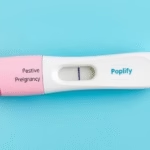Understanding Implantation Bleeding and Clots
Implantation bleeding occurs when a fertilized egg attaches itself to the lining of the uterus. This usually happens about six to twelve days after conception, leading to a light spotting that some women may mistake for an early period. It can vary in color from pink to brown and is generally much lighter than a typical menstrual flow. Not all women experience implantation bleeding, making it a somewhat uncertain indicator of pregnancy. When accompanied by clots, the situation can understandably cause concern among those who may not be familiar with this phenomenon. Clots, or small lumps of tissue and blood that may occur alongside the bleeding, can be confusing or alarming, prompting many to seek information to distinguish between normal implantation and a potentially concerning medical issue.
Common Signs of Implantation Bleeding
Recognizing the signs of implantation bleeding is essential for understanding your reproductive health. Implantation bleeding can vary significantly from woman to woman, but some common signs include:
Each of these signs can help differentiate implantation bleeding from a traditional menstrual cycle.
What to Expect with Clots During Implantation Bleeding
It is not uncommon to have some small clots during implantation bleeding. Clots during this phase do not typically indicate a health issue if they are small and infrequent. However, significant clotting can indicate other complications, such as hormonal imbalances or issues with the pregnancy itself. It’s vital to monitor the bleeding and seek medical advice if the clots are larger or accompanied by severe pain or heavy bleeding.
Generally, small clots are part of the normal tissue shedding that can occur when a fertilized egg attaches itself to the uterus. You may notice these clots being dark colored, suggesting they are older blood. However, if clotting is consistent or if you have concerns, consulting a healthcare provider can provide peace of mind.
When Does Implantation Bleeding Occur?
Timing is crucial when it comes to implantation bleeding. It typically takes place between 6 to 12 days post-ovulation, coinciding with the period when the fertilized egg embeds itself into the uterine wall. This timing generally aligns with a woman’s regular menstrual cycle, which can cause confusion for many. Women may mistake implantation bleeding for a light period and overlook the possibility of pregnancy.
Recognizing the cycle’s rhythms can aid in understanding whether light bleeding is indicative of implantation. If you have regular periods, tracking your ovulation can also help predict when implantation bleeding might occur. Understanding these patterns can empower women to recognize their body signals more accurately.
Can Implantation Bleeding Be Heavy?
Typically, implantation bleeding is light and brief. Heavy bleeding or prolonged periods coupled with clotting may indicate something else, such as an early miscarriage or other underlying health conditions. If you experience heavy bleeding resembling a normal menstrual period or even heavier, it is crucial to consult with a healthcare provider. They may perform tests or ultrasounds to assess the situation and ensure everything is progressing as it should be with the pregnancy.
Heavy bleeding can often cause anxiety among pregnant women. Therefore, understanding what is typical and what constitutes a health concern is vital for peace of mind and health management.
How to Differentiate Between Implantation Bleeding and Periods
Distinguishing between implantation bleeding and a menstrual period can be challenging, but several differences can help. Implantation bleeding is usually lighter in color and flow. In contrast, menstrual blood tends to be bright red and occurs at a heavier flow along with other symptoms, such as cramps and mood swings. Timing also plays an essential role; if the bleeding occurs earlier than expected, it could likely be implantation.
Tracking menstrual cycles can assist in identifying irregularities that may signal pregnancy instead of a standard menstrual flow. Women should observe their bodies and the pattern of bleeding closely for a week or so to recognize any critical differences. If there are persistent uncertainties, seeking a blood test or consultation can provide clarity.
Factors That May Influence Implantation Bleeding
A variety of factors can influence implantation bleeding, including hormonal changes and individual reproductive health. Women with irregular cycles may notice fluctuations affecting their timing for implantation bleeding. Conditions affecting hormonal levels, such as polycystic ovary syndrome (PCOS) or thyroid disorders, can also cause variations in bleeding.
Age and lifestyle factors may influence implantation as well. Younger women tend to have regular cycles, while older women may experience variability due to advancing age and health issues. Maintaining a healthy lifestyle with proper nutrition and exercise can contribute positively to reproductive health, thereby influencing implantation bleeding as well.
When to Seek Medical Attention
If you notice heavy bleeding, significant clotting, or intense abdominal pain, it is crucial to seek medical attention immediately. These can be signs of complications such as ectopic pregnancy or miscarriage. Early medical intervention can assist in safeguarding your health and addressing any severe issues that may arise.
Regular check-ups and being informed about your body can help you act quickly should any abnormalities occur. Understanding normal versus unusual symptoms prepares women to seek the necessary care without delay.
Final Thoughts
Implantation bleeding and its potential clot formation can be confusing for many women, especially when considering the emotional and physical changes linked to pregnancy. Recognizing the signs of implantation bleeding is essential, and understanding its timing, flow, and associated factors can help differentiate it from a menstrual cycle.
A good rule of thumb is observing the characteristics of the bleeding. Typically, implantation bleeding is light, short-lived, and not accompanied by significant pain or heavy flow. In contrast, menstrual bleeding is generally heavier and may cause discomfort through cramps.
Women should listen to their bodies, track their cycles, and reach out for medical advice if anything feels abnormal. Any heavy bleeding, severe clotting, or pain should prompt immediate consultation with a healthcare professional. A proactive approach to reproductive health enables women to navigate pregnancy with confidence.
Taking responsibility for your reproductive health will enable you to address your concerns head-on. Understanding what implantation bleeding entails lays a foundation for recognizing early signs of pregnancy and monitoring potential health risks associated with reproductive issues.
Frequently Asked Questions
1. What is the difference between implantation bleeding and a normal period?
Implantation bleeding is typically lighter, shorter, and occurs earlier than a normal period. In contrast, a menstrual cycle often involves heavier bleeding and may come with symptoms like cramps and hormonal changes.
2. How long does implantation bleeding last?
Implantation bleeding generally lasts from a few hours up to two days, whereas a typical menstrual period can last from three to seven days.
3. Can implantation bleeding occur with clots?
Yes, small clots can sometimes be present during implantation bleeding. However, larger clots or significant clotting should prompt medical advice.
4. Is implantation bleeding a sign of pregnancy?
Yes, implantation bleeding can be a sign of early pregnancy, but it is not experienced by all women. It is essential to track other pregnancy signs for confirmation.
5. When should I see a doctor for bleeding?
Consult a healthcare professional if you experience heavy bleeding, intense pain, or significant clotting, as this could indicate complications that require immediate attention.
Further Reading
What Type of Psychotherapy Is Best for Anxiety?







